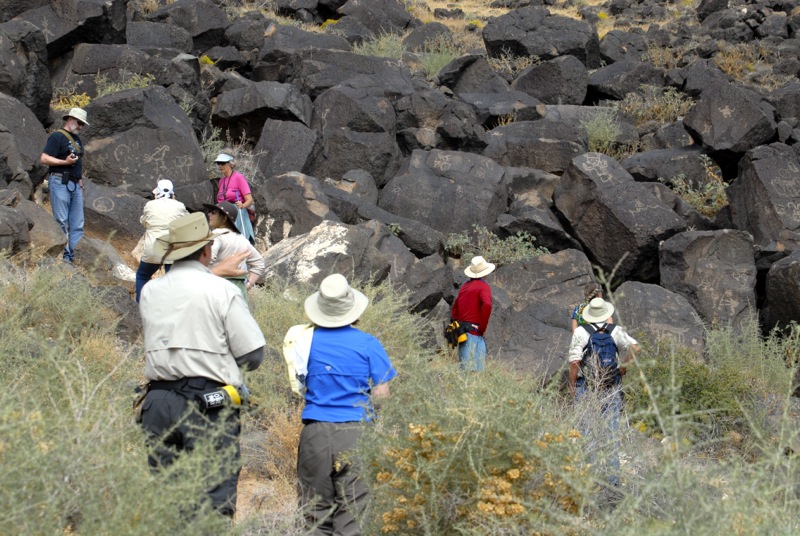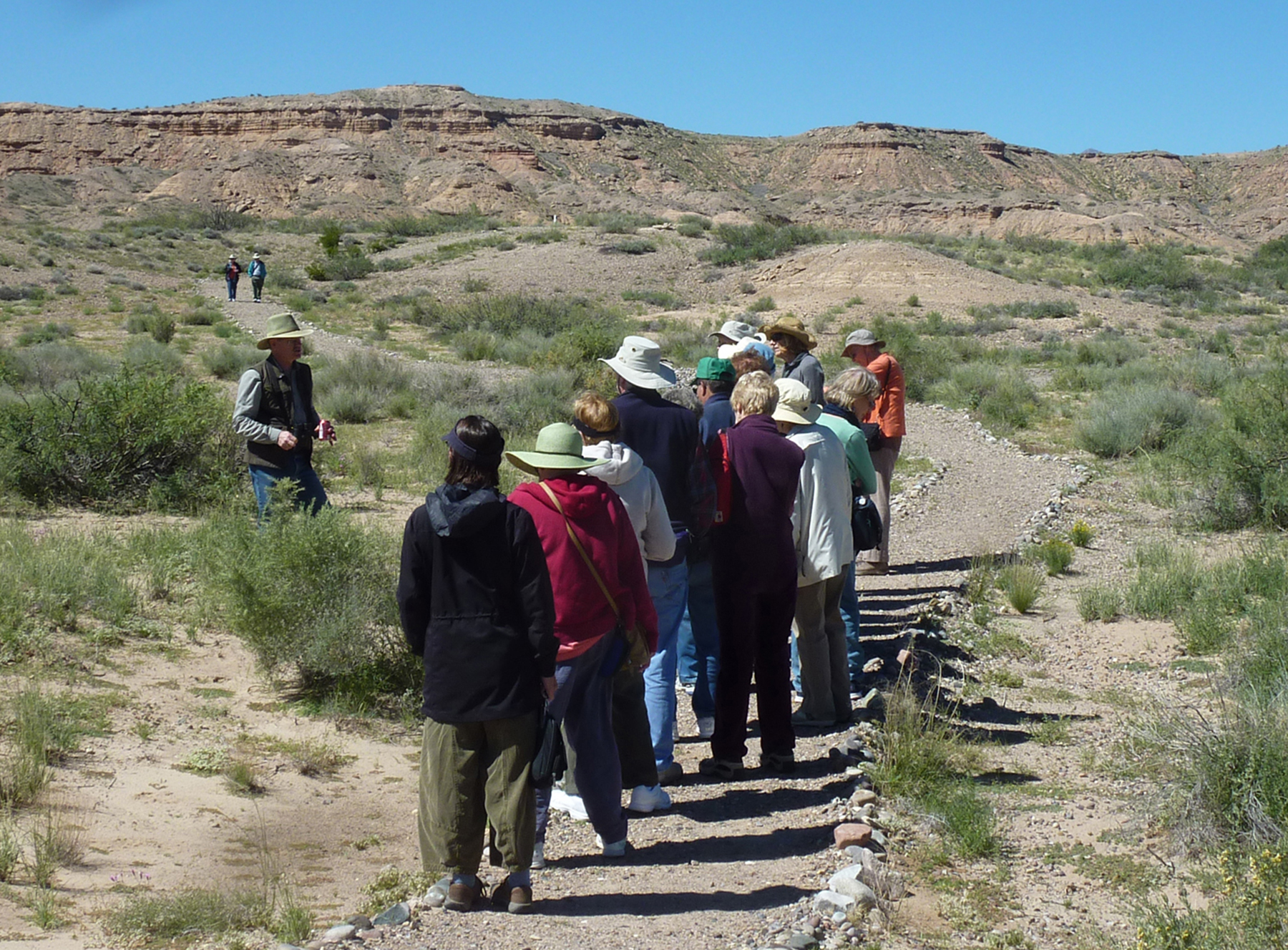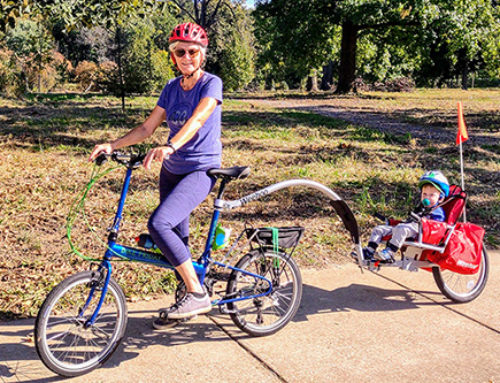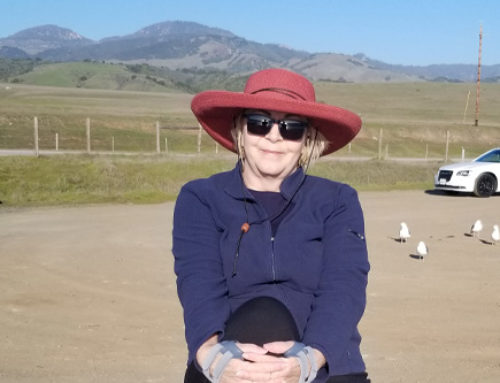It’s nice to find walking buddies, some friends who will keep you accountable as you build daily exercise into your routine. Many walkers find high school tracks, other outdoor routes, or even the local mall to get a few good miles in. My walking group from the Oasis Center in Albuquerque has found a way to exercise our bodies, while satisfying our curiosity.
 Together with our group leader, we pick venues and dates for our walks. Each walk is scheduled on a Monday, and repeated on Wednesday of the same week. The groups range from 20 to 45 members. Our purpose is to get out and explore. For each walk, the terrain is described ahead of time, so everyone can judge for themselves regarding safety. If a walk is more difficult, walking sticks and boots are suggested, but most participants come in tennis shoes.
Together with our group leader, we pick venues and dates for our walks. Each walk is scheduled on a Monday, and repeated on Wednesday of the same week. The groups range from 20 to 45 members. Our purpose is to get out and explore. For each walk, the terrain is described ahead of time, so everyone can judge for themselves regarding safety. If a walk is more difficult, walking sticks and boots are suggested, but most participants come in tennis shoes.The favorite walks are ones that inform and lead to places not known that have historical stories or plans for future development of environmental resources. Some walks have had experts on flowers, plants or butterflies along. The geologists always have good attendance for their sessions.
Two recent excursions are prime examples of the kind of “power walking” we enjoy.
Oasis Seniors, maps in hand, have stepped over broken sidewalks, and walked along the course of the acequia Madras de Albuquerque, the main or mother ditch, with historical houses of early settlers,watered orchards, gardens and powered flour grist mills. It was part of a water system older than the U.S. Government. The water no longer flows and few markings indicate the burial of this acequia.
The old Spanish town area of 1706 became the neighbor to the new railroad boom town of 1880. The railroad and merchants brought many changes. They built huge homes with block adobe, a popular building material used for many styles of architecture. Bricks along the territorial flat roof adobe houses keep the walls from melting and deteriorating. Prairie house and bungalow style homes were later architectural types seen in the area. The river bosque or woods changed when the saw mills and merchants arrived on the scene. Flood control measures were necessary and dams were built. Huge jetty jacks were installed along the river banks to hold soil in place. The flood damage was lessened. The barricades slowed fire fighting and sometimes made it impossible. Some jetty jacks, named for the likeness to the jacks of the children's game, still remain.
Another mind-enriching trek took us to the site of the Valle de Oro National Wildlife Refuge, the first urban refuge in the Southwest.
These restoration projects along the Middle Rio Grande/Albuquerque urban waters will be the first pilot watershed-based storm water management program, a climate change project and transportation and economic development initiatives in the South Valley. Director Jennifer Owen-White helped us imagine the project's growth and development.
Federal, tribal, state and local officials face challenges as they cooperate to balance resources, economic needs, protection of wildlife and social benefits for the people. We could envision the joy of sharing the riparian and wetland habitats, of the Rio Grande River, the trails and a welcome center. A bike and pedestrian bridge over the river would be an awesome addition, but sadly it is not in the original plans.
That day, the Oasis group plodded across the field, over or around the horse-people gate, to view the chocolate-brown Rio Grande, where seventy-year-old cottonwood trees stand with their yellow leaves of autumn beside the proud river flowing south to the Gulf of Mexico.
This spring, we’ll be exploring a number of ancient ditches (acequias) that supply irrigation water to the fields of the far and near north side of Albuquerque.
We will also tour the Open Space Visitor Center area, which includes one of the oldest and largest ancient Indian pueblo ruins in the Rio Grande Valley. This will include a walk through the beautiful bosque, which holds the artwork of local high school students.
A walk through the historic Huning-Highland neighborhood of Albuquerque, which dates from the “coming of the railroad” era, is also planned.
Although these walks were initiated many years ago, we are always looking for new opportunities!







Leave A Comment
You must be logged in to post a comment.